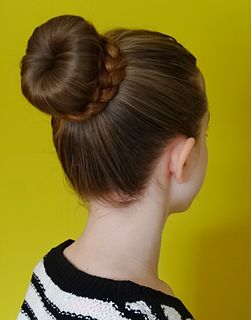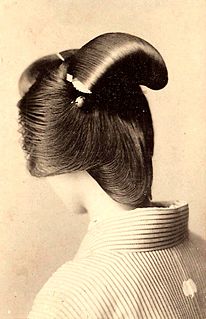
Macquarie Pass National Park is a national park in New South Wales, Australia, 90 km southwest of Sydney. It is located around the pass of the same name, which is on the Illawarra Highway and part of the Illawarra escarpment.

Threefin or triplefin blennies are blenniiforms, small percomorph marine fish of the family Tripterygiidae. Found in tropical and temperate waters of the Atlantic, Pacific and Indian Oceans, the family contains about 150 species in 30 genera. The family name derives from the Greek tripteros meaning "with three wings".

The chonmage is a form of Japanese traditional topknot haircut worn by men. It is most commonly associated with the Edo period and samurai, and in recent times with sumo wrestlers. It was originally a method of using hair to hold a samurai helmet steady atop the head in battle, and became a status symbol among Japanese society.
A tokoyama (床山) is a hairdresser employed by the Japan Sumo Association to cut and prepare sumo wrestlers' hair, which is done in a chonmage style. The Sumo Association ranks them according to experience and ability and only the most senior tokoyama are entitled to prepare the more ornate ōichō, or ginkgo leaf form of topknot, which sekitori ranked wrestlers wear in their bouts and on other formal occasions. It may not seem to the casual observer that such a position is necessary, but the elaborate hairstyle of sumo wrestlers, especially sekitori, combined with the combative nature of sumo bouts and sumo practice make it necessary for these professionals to be on hand to maintain the topknots as they are expected to look.

There are no extant representations of the Buddha represented in artistic form until roughly the 2nd century CE, partly due to the prominence of aniconism in the earliest extant period of Buddhist devotional statuary and bas reliefs. A number of early discourses describe the appearance of the Buddha, and are believed to have served as a model for early depictions. In particular, the "32 signs of a Great Man" are described throughout the Pali Canon, and these are believed to have formed the basis for early representations of the Buddha. These 32 major characteristics are also supplemented by another 80 secondary characteristics (Pali:Anubyanjana).

A bun is a type of hairstyle in which the hair is pulled back from the face, twisted or plaited, and wrapped in a circular coil around itself, typically on top or back of the head or just above the neck. A bun can be secured with a hair tie, barrette, bobby pins, one or more hair sticks, a hairnet, or a pen or pencil. Hair may also be wrapped around a piece called a "rat". Alternatively, hair bun inserts, or sometimes rolled up socks, may also be used to create donut-shaped buns. Buns may be tightly gathered, or loose and more informal.

Harakiri is a 1962 Japanese jidaigeki drama film directed by Masaki Kobayashi. The story takes place between 1619 and 1630 during the Edo period and the rule of the Tokugawa shogunate. It tells the story of Hanshirō Tsugumo, a warrior without a lord. At the time, it was common for masterless samurai, or rōnin, to request to commit seppuku (harakiri) in the palace courtyard in the hope of receiving alms from the remaining feudal lords.

The topknot pigeon is a pigeon native to eastern Australia. It is also known by the name of flock pigeon.

The New Zealand topknot, Notoclinus fenestratus, is a triplefin of the genus Notoclinus, found around the North Island of New Zealand in reef areas of broken rock and brown seaweed.

The ushnisha is a three-dimensional oval at the top of the head of the Buddha.
The brown topknot, Notoclinus compressus, is a triplefin of the family Tripterygiidae, endemic to New Zealand in rock pools and from low water to depths of about 5 m, in reef areas of broken rock and large brown seaweed of genera Carpophyllum and Cystophora. Its length is up to about 8.5 cm.

Nihongami is the term used for a number of traditional Japanese hairstyles considered to be distinctive in their construction and societal role.

Thonbanhla is the fifth of nats in the official Burmese pantheon of nats. She was a native of a Mon village called Takunnwan. She was (sic) "beautiful in three ways within one day." She was given to King Duttabaung of Pyay, but the queen was jealous of her beauty and told the king that she was actually very ugly and so fat that she could not fit through the city gate. Hearing this, the king refused to marry Thonbanhla who then died in despair. Another story says that she was the younger sister of Maung Tint De. She married King Smim Htaw Yama of Utthala and gave birth to a daughter, Shin Mi-hnè, but then died of a sudden illness. She is portrayed standing on an ogre bending over a dais supported by an elephant. She wears a topknot, her right hand on her chest and her left hand by her side.

Nyaunggyin is one of the 37 nats in the Burmese pantheon of nats. He was a descendant of the captive King Manuha of Thaton. He died of leprosy during the reign of King Anawrahta of Pagan. He is portrayed standing on a pedestal with a topknot, his left hand raised and holding a staff in his right.

Minyè Aungdin, husband of Princess Shwe Sin Tu, daughter of King Thalun and his queen, who was daughter of Sawbwa of Monè in Shan State. He died from an excess of opium smoking. He is portrayed sitting on a pedestal with a topknot and holding a harp.
Sathnam Sanghera is a British journalist and author.

Zeugopterus is a genus of turbots native to the north Atlantic Ocean. The two species reach a maximum length of 20–25 cm (7.9–9.8 in).

The Parabrahma Upanishad is one of the medieval era minor Upanishads of Hinduism composed in Sanskrit. The text is attached to the Atharvaveda, and is one of the 20 Sannyasa (renunciation) Upanishads.
The Boy with the Topknot is a 2017 British romantic drama film starring Sacha Dhawan and Joanna Vanderham. The film is based on Sathnam Sanghera's memoir of the same name.The film premiered on BBC. The film is about a Punjabi man who brings his English girlfriend home.














